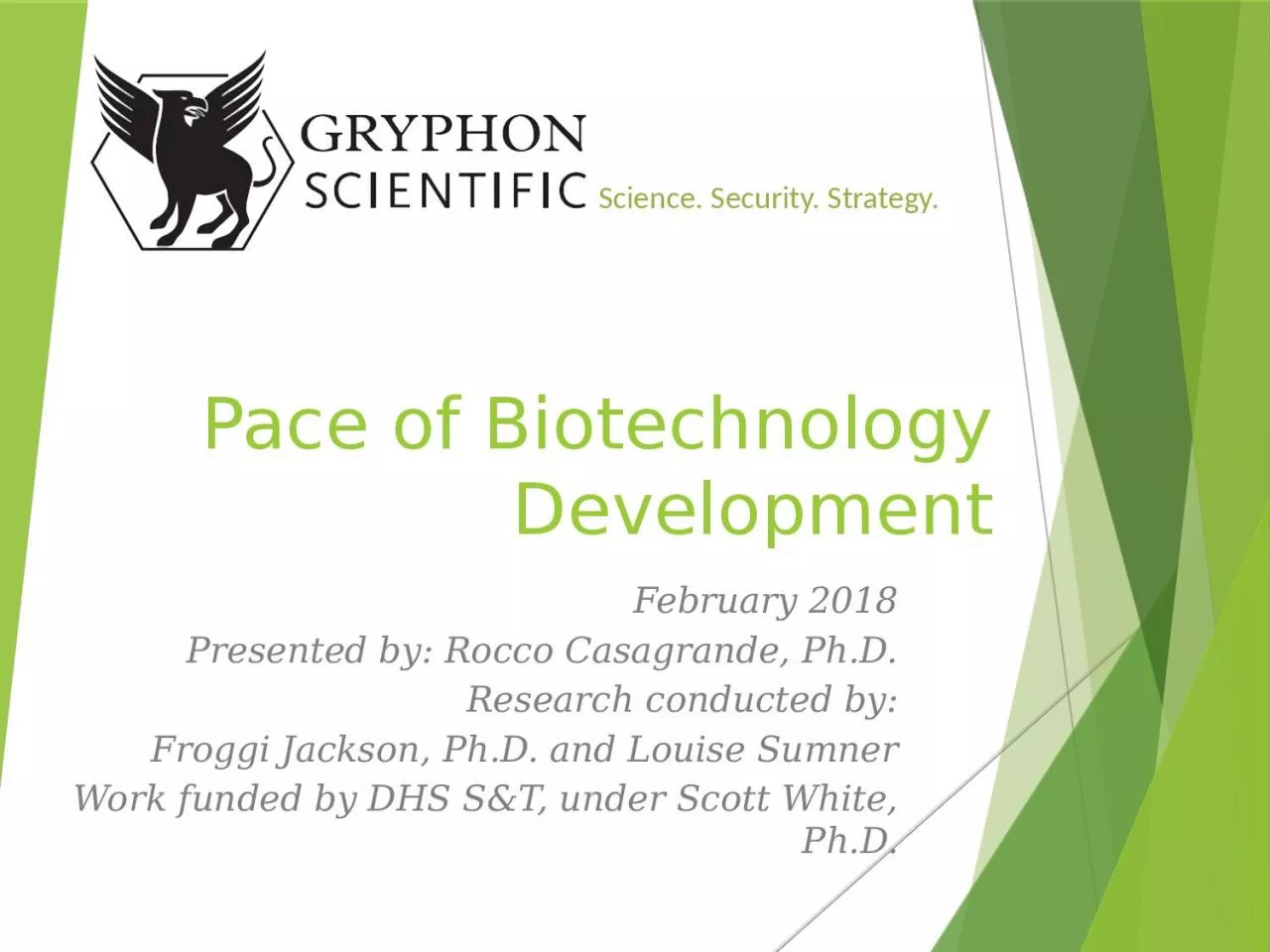

February 2018 Presented by Rocco Casagrande PhD Research conducted by Froggi Jackson PhD and Louise Sumner Work funded by DHS SampT under Scott White PhD Goals of the Study Assess developments in biotechnology to estimate ID: 1044996
Download Presentation The PPT/PDF document "Pace of Biotechnology Development" is the property of its rightful owner. Permission is granted to download and print the materials on this web site for personal, non-commercial use only, and to display it on your personal computer provided you do not modify the materials and that you retain all copyright notices contained in the materials. By downloading content from our website, you accept the terms of this agreement.
1. Pace of Biotechnology DevelopmentFebruary 2018Presented by: Rocco Casagrande, Ph.D.Research conducted by: Froggi Jackson, Ph.D. and Louise SumnerWork funded by DHS S&T, under Scott White, Ph.D.
2. Goals of the StudyAssess developments in biotechnology to estimate:The time between when a new trait is discovered/understood in a microorganism until that trait can be manipulated beyond what is seen in natureThese data inform us as to when an adversary could imbue a pathogen with traits that make it more usable in a weapon than the most dangerous natural strainsThe time over which a cutting edge technique in biotechnology can be accessed by individuals of modest skillThese data inform us about the time when a powerful technique could be usable by an adversary with little technical training
3. Manipulation of traitsDescribe a timeline for those modifications that affect traits of a microorganism relevant to weaponizationUnderstanding the genetics underlying the biology of the modifiable parameterReproduction of the modificationManipulation of the modificationCreating a modification not seen in nature (i.e. more pathogenic than wild type)
4. Duration (Yrs) Required to Reach a “Beyond Natural” PhenotypeAt 2020 = 2.3 y
5. Biotechnology Development Timelines ApproachFor technologies/techniques, use a case-study approach to describe timelines for:Spread throughout the fieldSpread to additional organismsEquipment developmentKit-ification/fee-for-service developmentReduction in required cost and skill
6. Case StudiesCell-free protein synthesis (CFPS)Clustered regularly interspaced short palindromic repeats (CRISPR) genome editingDNA/RNA extraction/purificationDNA microarrayDNA sequencingGenetic circuitsGreen fluorescent protein (GFP)In situ hybridizationPolymerase chain reaction (PCR)Mammalian cell cultureMolecular cloning (including restriction enzymes)Oligonucleotide synthesisPhage displayProtein extraction/purificationRecombinant protein expressionRNA interference (RNAi)Site-directed mutagenesisSolid-phase peptide synthesis (SPPS)Targeting Induced Local Lesions in Genomes (TILLING)Transcription activator-like effector nuclease (TALEN) genome editingYeast 2-hybrid systemZinc-finger nuclease (ZFN) genome editing
7. Example Case Study of Biotechnology Development Timeline: PCRDevelopment TimelineResource ThresholdsEventYearTechnical Resources (Education/Skill)Financial ResourcesEnabling discoveries-14 to -9N/AN/AFirst discovery0 (1985)HighUltra HighEssential equipment development0HighUltra HighEssential technical advancement (Taq)0HighHighReproduced in other labs1HighHighEssential equipment / materials commercially available2MediumMediumImproved price / accessibility of equipment3MediumLowReproduction outside academic laboratory (commercial service)4LowLowCommercial kit available5MediumMediumTaught at undergraduate level6LowMediumEssential technical advancements (Pfu; qPCR)6 to 7HighHighImproved equipment commercially available (qPCR)11MediumMediumTaught at high school level12LowLowFurther developments; improved price / accessibility of equipment18 to 25LowLow
8. Post-1973 AnalysisPre-1973: Time to medium skillPre-1973: Time to low skillInclusion of biotechnologies developed before the advent of molecular biology (1973) skewed the analysis since there was really no improvement in the speed of their development during the decades preceding 1973
9. Medium/Low Skill vs Initiation YearTime to medium skill vs initiation year (2.3y in 2020) (R2=0.17)Time to low skill vs initiation year (3.5y in 2020) (R2=0.38)
10. Fee for Service vs Initiation YearTime to fee for service vs initiation year (0.9y at 2020) (R2=0.77)
11. Medium/Low Finance vs Initiation YearTime to medium finance vs initiation year (2.2y in 2020) (R2=0.17)Time to low finance vs initiation year (3.6y in 2020) (R2=0.30)
12. Comparing future years-to-develop predictionsMetric20202025Medium skill2.32.1Low skill3.53.0Medium finance2.22.0Low finance3.63.1Fee-for-service0.90.612
13. ConclusionsConclusions:The time between the scientific understanding of a trait is established and the ability to manipulate it beyond what is seen in nature is already short, and getting shorter. We can expect that once complex traits are understood in the most dangerous pathogens, scientists will describe the ability to create even more dangerous strains in less than five yearsThe time that a powerful biotechnology technique, discovered by experts, gets into the hands of those with more modest skill sets is already short, and getting shorter. The pace at which biotechnology outsourcing is developing is accelerating the fastestWe can expect that a powerful new technique will be taught in college courses in less than five years